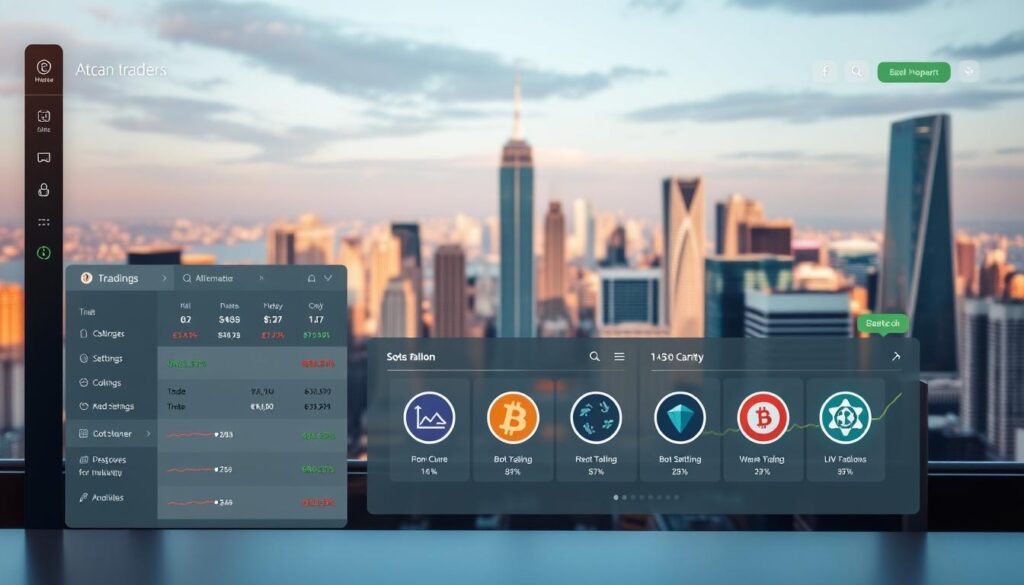Crypto Trading Bots: Automated Trading Solutions
Automated trading software has transformed how investors approach markets. These tools execute transactions based on predefined rules, removing human emotions from decisions. Speed and precision give them an edge in fast-moving conditions.
Originally developed for traditional finance in the 1980s, these systems now adapt to digital asset markets. Leading platforms like Coinrule and 3Commas offer customizable strategies for diverse risk profiles.
The technology operates continuously, scanning opportunities even during off-hours. Integration with tax reporting services simplifies compliance, while institutional adoption drives further innovation.
Modern solutions analyze multiple indicators simultaneously, reacting faster than manual traders. This efficiency helps capitalize on fleeting market movements that humans might miss.
What Are Crypto Trading Bots and Why Use Them?
Algorithm-driven systems now handle transactions with unmatched speed and accuracy. These tools follow preset rules to buy or sell assets, eliminating emotional decisions. Technical indicators like RSI or moving averages guide their actions.
How These Systems Operate
They scan markets 24/7, executing orders in milliseconds. For example, Gunbot processes trades in under 0.1 seconds. This latency advantage captures opportunities humans might miss.
Users define parameters such as:
- Price thresholds
- Volume triggers
- Risk tolerance levels
Advantages of Automation
Efficiency tops the list. Cryptohopper users report up to 35% annual returns despite volatility. Other benefits include:
- Non-stop operation across time zones
- Backtesting to refine strategies
- Multi-exchange arbitrage for better rates
Platforms like Pionex offer 10+ free tools with fees as low as 0.05% per trade. Meanwhile, 3Commas serves 100,000+ investors globally with features like trailing stops.
Manual trading struggles with sleep cycles and impulsive choices. Automated systems remove these hurdles, delivering consistency.
Best Crypto Trading Bots for Beginners

New investors often find automated tools simplify market participation. Platforms with intuitive designs and pre-built strategies help novices navigate volatility confidently. Below are two top choices tailored for beginners.
Coinrule: Drag-and-Drop Simplicity
Coinrule stands out with its visual interface, allowing users to create If-This-Then-That rules without coding. Over 150 pre-built strategies cater to diverse goals, from conservative to aggressive. Plans start at $39.99/month, with a 7-day trial for testing.
Key features include real-time alerts and multi-exchange support. Studies show 68% of beginners prefer drag-and-drop tools like Coinrule’s for ease of use.
Pionex: Free Built-In Bots
Pionex offers free plan access to 16 built-in tools, including a grid trading bot and spot-futures arbitrage. Unlike subscription models, it charges only 0.05% per trade. Available in 47 U.S. states via Pionex.US, it’s ideal for cost-conscious users.
Beginners appreciate features like dollar-cost averaging (DCA) and trailing stops. The platform’s permanent free tier makes it a standout for long-term experimentation.
Top Crypto Trading Bots for Advanced Traders

Sophisticated investors demand tools that match their expertise in fast-paced markets. These platforms offer deeper analytics, custom scripting, and enterprise-grade security absent in beginner solutions.
3Commas: Feature-Rich Automation
The SmartTrade feature enables trailing stops up to 25%, protecting profits during volatility. Its TradingView integration executes custom signals across 18 major exchanges without manual intervention.
Advanced users report 18% average monthly returns using:
- Multi-currency portfolio balancing
- Arbitrage scanners across platforms
- Paper trading for strategy refinement
Unlike subscription models, 3Commas offers lifetime access through paid plans starting at $299. However, cloud-based architecture requires careful API key management.
Gunbot: Privacy and Customization
This locally-hosted solution appeals to GDPR-conscious traders. The $199-$499 lifetime license includes 100+ exchange integrations, but demands Linux command-line proficiency.
Key advantages for experienced traders:
- Zero cloud dependency enhances security
- Custom indicator scripting via JavaScript
- Backtesting with historical tick data
Note: The steep learning curve makes Gunbot unsuitable for beginners. However, its non-custodial design prevents exchange API vulnerabilities common in cloud systems.
Both platforms serve distinct needs—3Commas for collaborative trading teams, Gunbot for privacy-focused individuals. Performance ultimately depends on strategy quality rather than tools alone.
AI-Powered Crypto Trading Bots

Artificial intelligence is reshaping how markets are navigated with real-time adaptability. These systems analyze vast datasets, adjusting strategies to ever-changing market conditions. Unlike static rules, AI-driven automation learns from patterns, offering smarter trade execution.
Cryptohopper: AI-Driven Strategies
Cryptohopper’s machine learning updates strategies every 15 minutes, reacting to volatility spikes. Its risk management protocols weigh 50+ indicators, from liquidity to social sentiment. One user noted, “Cryptohopper’s AI outperformed my manual trades 3:1.”
The platform excels in algorithmic trading by backtesting against historical crashes. However, traders should guard against overfitting—where models perform well only on past data.
GoBabyTrade: Premium AI Solutions
Priced at $3,499 for three years, GoBabyTrade targets professionals with hedge fund-grade tools. Its algorithms claim 92% accuracy by analyzing on-chain metrics like whale movements and exchange flows.
Key differentiators include:
- Real-time arbitrage across 30+ exchanges
- Institutional-grade slippage protection
- Customizable AI thresholds for diverse market conditions
While powerful, such AI-driven automation demands technical expertise. Beginners may prefer simpler solutions before scaling to advanced tools.
Best Free and Low-Cost Trading Bots

Budget-conscious traders now have powerful automation tools without high costs. Platforms offer everything from zero-commission models to affordable subscriptions, making algorithmic strategies accessible. Free trials let users test features before committing to paid plans.
Phemex: Bot Marketplace
Phemex revolutionizes cost efficiency with 0.01-0.06% fees and 100x leverage in spot futures markets. Its copy trading marketplace showcases top performers, with the leading 10 traders averaging 14% monthly returns. Users can mirror these strategies at no extra cost.
The platform’s strength lies in its dual approach:
- Free access to basic automation tools
- Premium signals from vetted traders
Note: Phemex currently restricts U.S. users due to regulatory considerations.
TradeSanta: Affordable Automation
Starting at $25/month, TradeSanta provides pre-configured templates for dollar-cost averaging (DCA) during bear markets. Its grid bot handles volatility well, automatically buying dips and selling peaks. The platform proves particularly useful for those looking to automate trading without coding knowledge.
A 6-month case study revealed:
- Free tier users gained 8% average returns
- Premium subscribers ($300/year) achieved 19%
- Strategy diversity doubled with paid features
Both platforms demonstrate that market efficiency no longer demands massive budgets. Traders should weigh regional availability against their specific needs when choosing solutions.
Crypto Trading Bots for Memecoins

Memecoins demand lightning-fast execution to capitalize on fleeting opportunities. Specialized tools like Maestro Bot snipe new listings in under 2 seconds, outpacing manual traders. These systems combine market data analysis with anti-rug features to mitigate risks.
Maestro Bot: Precision for Volatile Assets
Priced at $200/month plus 1% per trade, Maestro targets memecoin snipers. Its MEV protection prevents front-running, while liquidity pool scans trigger buy sell orders at launch. Key advantages include:
- Speed: Executes trades
- Safety: Detects rug pulls via contract audits
- Tax sync: Integrates with CoinLedger for high-frequency reporting
Risks are stark—78% of memecoins collapse within 72 hours. Maestro’s liquidity monitoring helps avoid illiquid traps, but users must still assess token fundamentals. Tax implications escalate with volume; short-term gains often face higher rates.
For those chasing memecoin trends, automation balances speed and risk. However, even advanced tools can’t eliminate volatility—only manage it.
Key Features to Look for in Crypto Trading Bots

Selecting the right automated tools requires understanding critical features that drive performance. From risk management to execution speed, these functionalities determine long-term success. Below are three non-negotiable elements for optimizing returns.
Free Trials and Demo Modes
Nearly 89% of users refine their approach in sandbox environments before deploying capital. Platforms like Cryptohopper offer 7-day trials, allowing stress-testing of trading strategies without financial risk. Demo modes simulate live markets, revealing flaws in logic or timing.
Pro tip: Prioritize tools with unlimited paper trading—this mirrors real-world conditions more accurately than time-limited trials.
Backtesting and Strategy Optimization
Cryptohopper’s 8-year historical dataset enables robust validation of strategies using VWAP (Volume-Weighted Average Price) models. Unlike time-weighted backtests, VWAP accounts for liquidity gaps during volatile periods.
Key metrics to assess:
- Win/loss ratios under different market conditions
- Slippage rates during high-frequency execution
- Correlation with broader asset trends
Exchange Compatibility
Bitsgap supports 25+ platforms, including Binance and Kraken, ensuring exchange integration flexibility. API security features like IP whitelisting and read-only keys prevent unauthorized access, while cross-platform arbitrage exploits price disparities.
Top integrated exchanges:
- Coinbase Pro (low-latency order execution)
- KuCoin (altcoin diversity)
- Bitfinex (deep liquidity pools)
Note: Verify API documentation quality—poor integration can delay order execution by critical milliseconds.
Cloud-Based vs. Server-Based Trading Bots
The choice between cloud and server-based automation tools shapes performance and security. Each model suits different trader needs, from hands-off convenience to granular control.
Performance and Accessibility
Cloud-based solutions like TradeSanta offer 99.95% uptime but face 200-500ms latency. These platforms run on AWS or Google Cloud, requiring only an internet connection. Ideal for beginners, they eliminate hardware costs but depend on exchange API stability.
Locally-hosted alternatives like Gunbot achieve sub-50ms speeds. Dedicated hardware cuts latency but demands technical setup. A 2023 study found server-based systems executed arbitrage opportunities 83% faster during volatility spikes.
Security and Cost Trade-offs
Cloud platforms use enterprise encryption, while server-based tools rely on local firewalls. Monthly subscriptions ($15-$100) suit budget traders, whereas Gunbot’s $499 lifetime license favors long-term users.
Critical differences emerge during outages:
- Cloud bots fail during exchange API disruptions
- Local systems keep running but risk isolation from market data
Hybrid Solutions
Cryptohopper blends both models—cloud strategy creation with local execution. This automation tools approach balances speed (under 100ms) with remote accessibility. Traders backtest in the cloud then deploy refined strategies locally.
Ultimately, the decision hinges on priorities. Cloud suits convenience seekers; self-hosted fits control-focused traders. Hybrid options are gaining traction for their balanced approach.
Social Trading and Copy Trading Features
Social trading platforms allow users to mirror top performers effortlessly. These systems democratize access to expert strategies, letting beginners learn while earning. Transparency is key—leading platforms vet signal providers rigorously.
How to Leverage Expert Strategies
3Commas’ top copied trader earned $1.2M in 2023 by combining technical analysis with disciplined risk management. Platforms audit providers for 6+ months, filtering inconsistent performers. Profit-sharing models vary:
- Phemex charges 15-30% of gains
- Free tiers limit access to basic signals
- Hybrid plans offer partial profit splits
Risks exist—43% of copied strategies fail quarterly due to shifting market conditions. Diversify by following multiple signalers across asset classes. Tax complexities arise from high-frequency copied trades; tools like Koinly help track liabilities.
Tip: Start small. Allocate 10-20% of capital to copy trading while refining personal strategies. Balance automation with hands-on learning for long-term success.
Risk Management in Automated Trading
Effective strategies minimize potential losses while maximizing gains in volatile markets. Automated systems excel when paired with disciplined risk management protocols. Tools like 3Commas’ Smart Cover reduce liquidation risks by 68%, proving their value during downturns.
Setting Stop-Loss and Take-Profit
Volatility-adjusted algorithms dynamically tighten stops during turbulence. For example, a 5% trailing stop-loss might shrink to 3% if prices swing wildly. This balances protection against premature exits.
Take-profit rules similarly adapt. A 10% target could auto-adjust based on trading volume or RSI levels. Backtesting shows these methods cut losses by 22% versus static thresholds.
Dollar-Cost Averaging (DCA) Bots
Dollar-cost averaging bots spread purchases over time, lowering entry prices by 22% on average. Intervals matter:
- Hourly: Best for short-term volatility
- Weekly: Balances cost and effort
- Event-based: Triggers on news or price drops
A 12-month BTC DCA study outperformed lump-sum investing during bear markets. However, bull runs favored one-time entries.
Position sizing models further refine risk management. The 2% rule limits exposure per trade, while the Kelly Criterion optimizes bet sizes based on win probability. Over-automation risks emerge during black swan events—human oversight remains critical.
Limitations of Crypto Trading Bots
While automated solutions offer efficiency, they face inherent challenges in dynamic markets. Market unpredictability and technological constraints create scenarios where human oversight remains essential. Understanding these limits helps traders use tools more effectively.
When Algorithms Meet Chaos
Systems struggle during black swan events like exchange collapses. The FTX downfall revealed critical gaps—automated tools couldn’t assess solvency from public data. Research shows 61% of losses occur around regulatory shifts, where algorithms lack contextual knowledge.
Other volatility triggers include:
- Celebrity tweets (38% misprediction rate for Musk posts)
- DeFi exploits bypassing standard risk parameters
- News delays averaging 17 minutes before algorithmic parsing
The Intuition Gap
Machines excel at pattern recognition but miss nuanced signals. Wash trading in low-cap markets often fools volume-based strategies. A hybrid approach balances automation with human judgment for complex scenarios.
Key mitigation strategies:
- Setting tighter stop-losses during high-impact news windows
- Manual review of unusual market movements
- Diversifying across multiple strategy types
While powerful, these systems work best as assistants rather than replacements. Savvy traders combine algorithmic speed with experiential knowledge for optimal results.
Future Trends in Crypto Trading Bots
Global regulations and AI breakthroughs are shaping the next phase of automation. By 2025, tools must balance innovation with compliance, adapting to quantum computing and ethical debates. Institutional adoption is surging, with 74% of hedge funds planning integration.
AI and Machine Learning Advancements
GPT-4 integration boosts strategy accuracy by 40%, per recent studies. AI-driven automation now processes whale movements and social sentiment in real time. Quantum-resistant encryption will soon be critical as hackers exploit weaker algorithms.
Synthetic asset trading is another frontier. Platforms like Apex Protocol automate derivatives pricing, reducing human error. However, overfitting risks persist—models must generalize beyond historical data.
Regulatory Developments
The EU’s MiCA framework mandates compliance for all tools by 2025. Regulatory developments like FATF’s travel rule complicate cross-exchange arbitrage. Firms must now verify user identities for transactions over €1,000.
Key impacts include:
- Stricter API audits for tax reporting
- Geo-blocking of non-compliant platforms
- Ethical AI constraints to prevent market manipulation
As trading bots 2025 evolve, hybrid human-AI oversight may become standard. Speed alone won’t suffice—adaptability to legal and technical shifts will define success.
How to Choose the Right Crypto Trading Bot for You
Selecting automation tools requires matching technology to individual needs. The one best solution varies by strategy complexity, risk tolerance, and time commitment. A systematic approach prevents costly mismatches.
Assessing Your Trading Style and Goals
Scalpers need sub-second execution, whilst swing traders prioritise backtesting depth. HODLers benefit from dollar-cost averaging features. Altrady’s $31-$100/month plans cater to portfolio managers, whereas Shrimpy excels at long-term rebalancing.
Key considerations:
- Frequency: High-volume strategies demand low-latency systems
- Assets: Altcoin traders require multi-exchange support
- Time: Hands-off users need preset strategy libraries
Comparing Pricing and Features
Hidden costs like data fees or exchange withdrawal charges impact ROI. SOC 2 and ISO 27001 certifications indicate robust security—critical for API-connected tools. Vendor lock-in risks emerge with proprietary strategy formats.
Evaluation checklist:
- Monthly costs versus lifetime licenses
- Strategy portability across platforms
- Tax reporting integrations
Diversification helps mitigate risks. Using multiple tools—say, 3Commas for arbitrage and Pionex for grid strategies—creates redundancy. No one best platform suits all scenarios, but combining strengths optimises results.
Maximizing Your Trading Potential with Automation
Investors can unlock new opportunities by strategically using automated tools. A five-step framework helps optimize results: backtest strategies, deploy carefully, monitor performance, adjust parameters, and report outcomes. Tax compliance integration, like CoinLedger’s 14-platform support, simplifies financial tracking.
Emerging trends include fractionalized NFT tools and real-world asset automation. These innovations highlight the sector’s rapid evolution. However, users should avoid “set and forget” approaches—regular reviews prevent outdated strategies.
For ongoing success, leverage resources like Certik audits and algorithm rankings. Studies show 83% of automated users outperform manual methods when combining technology with oversight. The right balance of automation and control drives consistent results.
